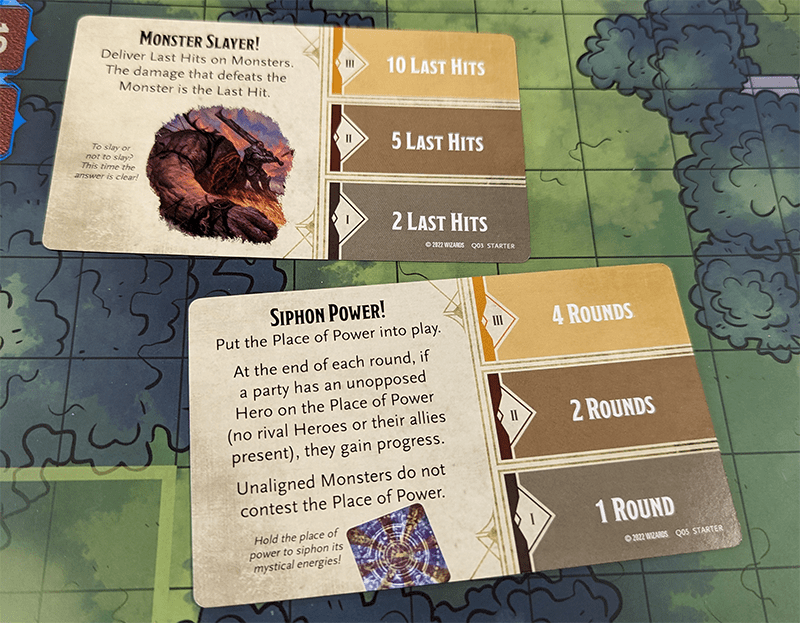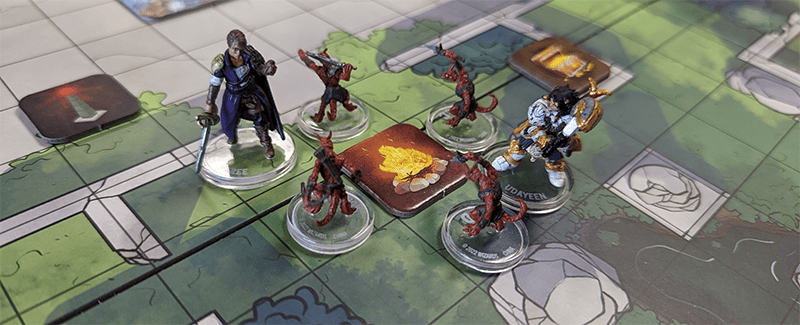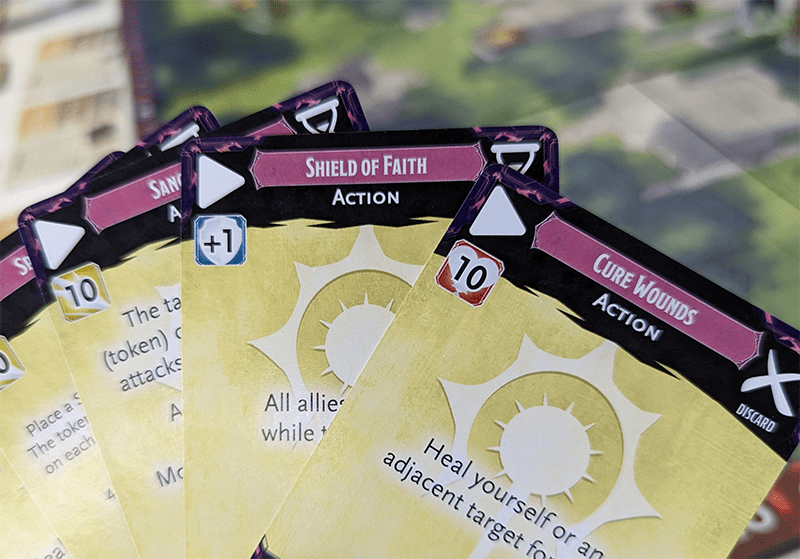Disclosure: Meeple Mountain received a free copy of this product in exchange for an honest, unbiased review. This review is not intended to be an endorsement.
Images of social deduction games like Werewolf or party games using words or drawings often come to mind when thinking of 8-player board games. However, it is very rare to find a game that can provide an enjoyable, full-fledged board gaming experience for a large group of players. Finding such a game is almost as rare as a sensible Kickstarter project or a rulebook that the average person can understand.
Trials of Tempus wants to plant its flag in this sparse arena, utilizing the Dungeons and Dragons ruleset and combining it with the past decade of online video games such as League of Legends. While this is a team-based skirmish game about a competition between two parties of powerful people, it goes beyond those first impressions.
Your party will win by accumulating victory points, not kills, and most of these points will come from completing quests. Every session will offer three random quests for you to complete. These can range from simple tasks, such as going to a certain spot and doing a skill check, to more complex objectives, like protecting your Ogre Prince while slaying the enemy Ogre Prince.
Once a team reaches 10 victory points at the end of a round, the Trial Guardian shows up and starts causing mayhem. Beat the Trial Guardian, and the game ends.
That’s the basic premise: do quests, murder things, kill the big bad, and the game is done.

Let’s Explore The Guts
The first decision you’ll make is to pick your character. In typical Dungeons and Dragons fashion, there is customization here. Not only will you pick your class, but you will also pick a subclass and a character. If you’re new, it has recommended builds, and they work fine.
Despite this being a Dungeons and Dragons-licensed game, this is a card-driven experience. Your choice of class and character determines your deck, and at the start of every round, you will draw cards. After drawing your cards, an Event card is revealed that gives some special effect for the round. It could be anything from healing, drawing an extra card, a lightning strike, or a new monster showing up. Someone on the design team is a fan of The Hunger Games.
Since this is a combat-focused Dungeons and Dragons game, the next obvious step is rolling for initiative to determine the turn order for the players. Turns are simple: you have two actions to spend however you wish, usually using your Primary actions like movement, skill checks, and basic attacks.
The main course of the action system is going to come from your hand. Some of your cards can be spent as Actions such as ongoing spells, stronger attacks, or abilities. Chain cards allow you to modify an existing action. For example, if you are playing the Monk and do a Move action, you can play the Parkour Chain card, which allows you to move through one space of impassable terrain. Awesome stuff. Free action cards are exactly what they mean. You can play them anytime, including your opponent’s turns. This also means other players can do the same thing, and this “stacking” of effects is similar to Magic: The Gathering, as in last played, first out.
Some people might groan upon reading the previous sentences, claiming that this is not original. I can’t deny that point. This system of playing cards out of turn and following the text has been around for decades. Nevertheless, this is an eight-player game, so I prefer to get players emotionally invested quickly and easily rather than making them go through a complex “innovative” system.
THAC0 Tuesdays
This isn’t to say there is nothing original here. Trials of Tempus has one amazing system: Interactions. Each class can use their Interaction ability once per ally’s turn by discarding a card. For example, a Monk can give an ally two extra spaces to move, a Wizard can enhance an ally’s attack to set people on fire, and a Cleric can discard a card to heal for 5 HP. This system lightens the heavy burden of downtime and is something other designers should steal.
Of course, this wouldn’t be Dungeons and Dragons without monsters, and they do play a role here. They are always at initiative 10, and they all activate in a particular order. The good news is that most of them aren’t heavily scripted. If they are active, meaning they were damaged during the round, or they see a Hero two spaces away from them, they do their part. Most of them will simply move towards the closest target they can see and attack, with the opposing team controlling their movement path. If they can’t see the target and are active, they make a beeline towards the middle of the map.
This does lead to my first point of criticism. The behavior of the monsters can appear rather peculiar. On one turn, they might vigorously pursue a target, only to remain stationary for several subsequent turns if left unprovoked or without any nearby Heroes. Unless I’ve misunderstood the rules entirely, this aspect feels somewhat unsettling and raises a few eyebrows. (Post-Edit: According to the designer, I am wrong. When a camp is active, it’s active until defeated, meaning they will attack and pursue to anyone in line of sight)

Lukewarm Dagger +2
The Monsters do serve a purpose. Some quests want you to kill monsters, but more importantly, they drop loot. You can hoard as much loot as you like, and each loot gives you 1 victory point as long as you have it. Loot also provides more ways to break the rules, such as additional ways to attack or some form of passive ability. Most of them are based on familiar Dungeons and Dragons items like the Flame Tongue and Heartseeker.
Since I’m on the topic of monsters, there are four Trial Guardians you can use in your session. You have your basics, like the Hill Giant, who likes to attack twice in melee or hurl giant rocks toward people, or something more annoying, like the Guardian Naga, who likes to set you on fire and poison you.
Having reviewed Stonebound Saga and Reload, skirmish games aren’t unfamiliar territory to me. I have also played many deckbuilders and recently reviewed a card battler, Hero: Tales of the Tombs. Combining these two elements seems like an odd choice, but it works—though not perfectly, as I will discuss later in my grievances.
During my many sessions of Trials of Tempus, I immediately noticed how it kept the spirit of Dungeons and Dragons alive within this board game form. Your character is a complete badass at their job, and you can showcase that by performing powerful game-altering abilities almost every turn. The Wizard tests your love for pyromania, the Fighter can easily socially distance your torso from your legs, and the Monk welcomes you if you enjoy making references to Fist of the North Star.
High-Five Slaughter
Surprising me the most is this perfect blend of teamwork and individuality. With the map being so large and objectives scattered all over, it’s common for players to separate and then meet up at essential points during the match. For instance, when I played the Wizard in my last session, I darted around the terrain, reading Runes to get points, and then rushed back to the middle to attack the enemy Paladin attacking my Monk by casting Magic Missile. With a swift casting of Magic Missile, I unleashed a devastating assault, as if the words of a spirited wrestling announcer echoed throughout the table, amplifying the excitement of the moment. This is no mere clash of miniature armies against each other; it’s a game that encompasses diverse strategies intersecting amidst a backdrop of exhilarating randomness.
Another point of praise for Trials of Tempus is that it makes it easy for newcomers to understand the flow of the game, reminding me of older tiles like Heroscape or Heroquest where the rules don’t get in the way. With a handful of actions to use and only two actions per turn, the pacing of the game is frictionless. Making an attack or a skill check is a simple roll of the famous twenty-sided die, with higher results leading to better outcomes. In contrast to other adventure games that feel like a bureaucratic process, this one offers a refreshing experience and spares you the labor of reading an 80-page rulebook to know if your dude stabbed another dude.
Thanks to its simple rules and seamless flow, the captivating spirit of the game engulfs everyone within a New York Minute. Around the table, lively discussions arise about prioritizing objectives, urgent calls for assistance echo from team to team when facing formidable enemy Heroes, and countless conversations culminate with the resounding phrase, “trust me.” This is no intricate puzzle requiring complex calculations on a grid; instead, it harks back to the battle games of yesteryear, where simplicity and dice rolls reign supreme.
All this sounds great until the Trial Guardian shows up. It’s at this point that I have to suck the air between my teeth.

The Big Bad In Several Ways
I’ll start with the easiest problem to discuss: Player scaling. No matter how many players you have at the table, the number of hit points for the Trial Guardian is always the same. I’m going to use simple math here to explain my reasoning, demonstrating once again that Dungeons and Dragons is truly Satan’s game.
For the sake of brevity, we’ll use the 100-HP Hill Giant Trial Guardian. As explained before, he likes to throw rocks and club people to death. Assuming you are playing 4 vs. 4, that means a team would have eight actions for every attack from the Hill Giant. I will state that this is fair and, dare I say, perfect. Now reduce that to two players per team, and suddenly that’s four actions for every attack. In other words, it’s going to attack twice as often, and it will take twice as many rounds to defeat it.
This wouldn’t be too much of an issue if damage was sensible, but it isn’t. For the Hill Giant, he will attack twice with preference to two separate targets for 12 damage, and if you’re too far away, he throws a rock at you for 20 points of damage. Everyone’s health is at 30, with some characters having damage reduction. So, if you’re someone with low damage reduction, like a Bard or Monk, a Hill Giant can take anywhere from one to two-thirds of your health in one attack. It wouldn’t be an issue if there were more people to take the blow, but there are only two of you, and healing is scarce.
If that didn’t sound painful enough, it gets worse. Since there are fewer players on the field, that means each player will carry more loot. So if you die horribly, you are potentially putting your team at risk since you are losing many points unless you die in a favorable spot.
Looking At The Bright Side
What’s frustrating about me talking about this is that there is a bandaid fix, and some of you might’ve already thought about it as you are reading these sentences. What is it? Reduce the HP of the Trial Guardians and Elites based on the number of players. 2 vs. 2? 50% off. 3 vs. 3? 25% off. I’ve tried this house rule with some repeat players in my group, and they all agreed that this was a good change.
The Trial Guardian’s conceptual issues remain unresolved despite this seemingly happy ending. It offers no rewards outside of a tiebreaker, so players have no incentive to end the game unless they have a large lead. By damaging the Trial Guardian, players are sacrificing their chances to score points through quests. Ultimately, the Trial Guardian is nothing more than a glorified violent sand timer.
I am going to throw out some theories on why this is the case. First, to avoid a “rich get richer” situation, which makes sense. Another possibility is that it serves as a catch-up system. If one team rushes to 10 points, it gives the other team time to catch up and sweep the game at the last minute due to the huge commitment of resources necessary to take it down.
This does lead to an intriguing incentive for players to adopt various approaches, whether through teamwork, splitting up, or taking daring risks by going all-in on the Trial Guardian. However, this intriguing dynamic also means that the game’s outcome heavily relies on the players’ skill levels. Consequently, those who struggle or exhibit suboptimal gameplay may inadvertently extend the duration of the game, potentially leading to frustrating experiences.

It’s All Good At The End
Reflecting on my own gameplay sessions, I’ve witnessed a range of game lengths, with the shortest lasting approximately 2.5 hours and the longest stretching to 3.5 hours. In certain instances, we even had to declare the 10th round the final one, signifying the need for a definite endpoint. To streamline future gameplay experiences, I would recommend considering a 15-point cap and introducing a predetermined round limit, preferably between 8 and 10 rounds.
And the dumbest part? I still love it. No doubt, the Trial Guardian idea is a mixed bag, and it will not surprise me if it becomes a subject of controversy for other reviewers. But everything before that? Perfect. The action economy, the powerful abilities, the map size, and the card play system all work in unison like a structure crafted by master engineers.
Each time my friends and I gather to play Trials of Tempus, an electrifying energy fills the air, palpable through the enthusiastic air pumps and triumphant fist bumps. It is during these moments, when we execute incredible maneuvers or provide timely assistance to one another on the battlefield, that the game truly comes alive. Standing out in an industry that offers few titles of similar scope, Trials of Tempus holds a special place. There are no other eight-player games of this caliber in existence.
Trials of Tempus deserves commendation for daring to venture into uncharted territory and excelling despite encountering a few noticeable bumps along the way. Like a sleek Ferrari among other vehicles, it captivates with its unique charm and distinctiveness. Just as Ferraris are not meant for everyone, Trials of Tempus caters to a specific audience, and that is perfectly fine.











Thank you for your review, Mark! You’ve been fair and make great points, and I’m absolutely thrilled to see the joy of playing our game shine through as you write. 🙂
As far as minion behavior goes, once activated by any means, they remain so and take turns every round until defeated, they should never be standing around doing nothing unless they are literally in the center of the board and still cannot see any targets at any range.
Perhaps rightly so, the Trial Guardians have turned out to be a mixed bag for reviewers so far, and you hit the nail on the head in regards to some of the “why’s” behind it all. I’ll add this: The Guardian is meant to represent a new and final phase of the game, forcing a marked shift in playstyle. They are meant to be “overpowered” if their mechanics aren’t exploited or handled effectively, more so in a game of 2v2, but each are meant to have weaknesses or triggers that can be manipulated and used against them or to make them act in suboptimal ways. Hence why they are drawn at the start of the game, and can be “planned” against from the Hero Deck building stage. Kiting and CC work wonders!
That said, scaling them as you suggest is an effective way to shorten games a bit and make the endgame less scary for teams with a slim lead.
Again, a heartfelt thank you for the time you’ve put into this, and for your kind and reasoned words.
-Thor
Thank you for the kind words!
Since we are discussing about rules, I noticed the player aids mention chain damage can be used on top of chain attacks cards. However, the rulebook states that chain cards can only be used per action spend (e.g. so either damage or attack chains)
Which one is it?